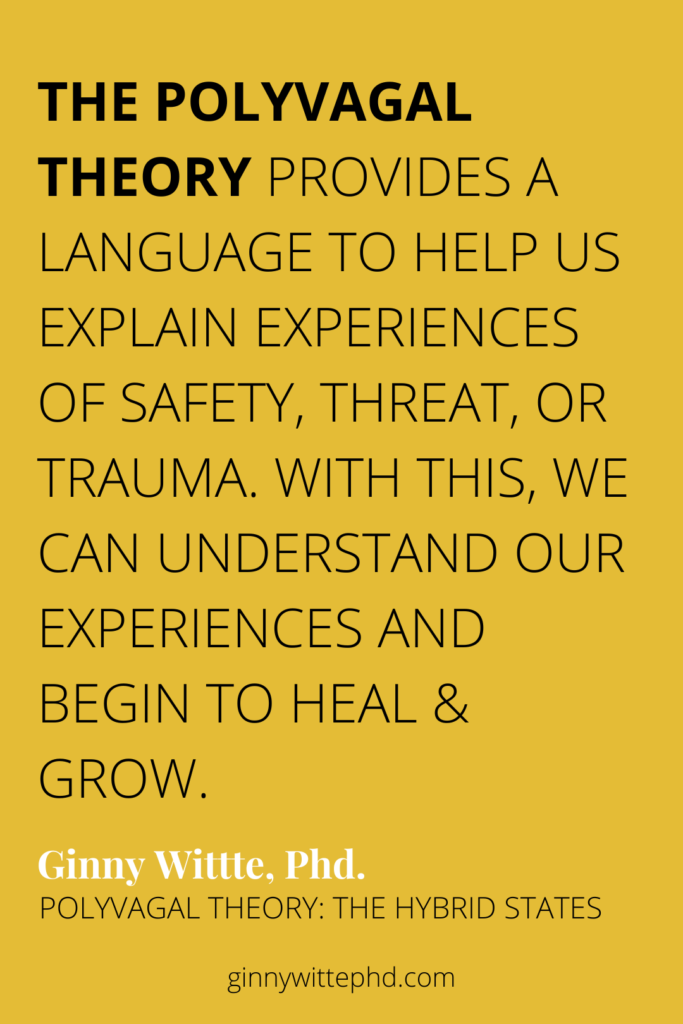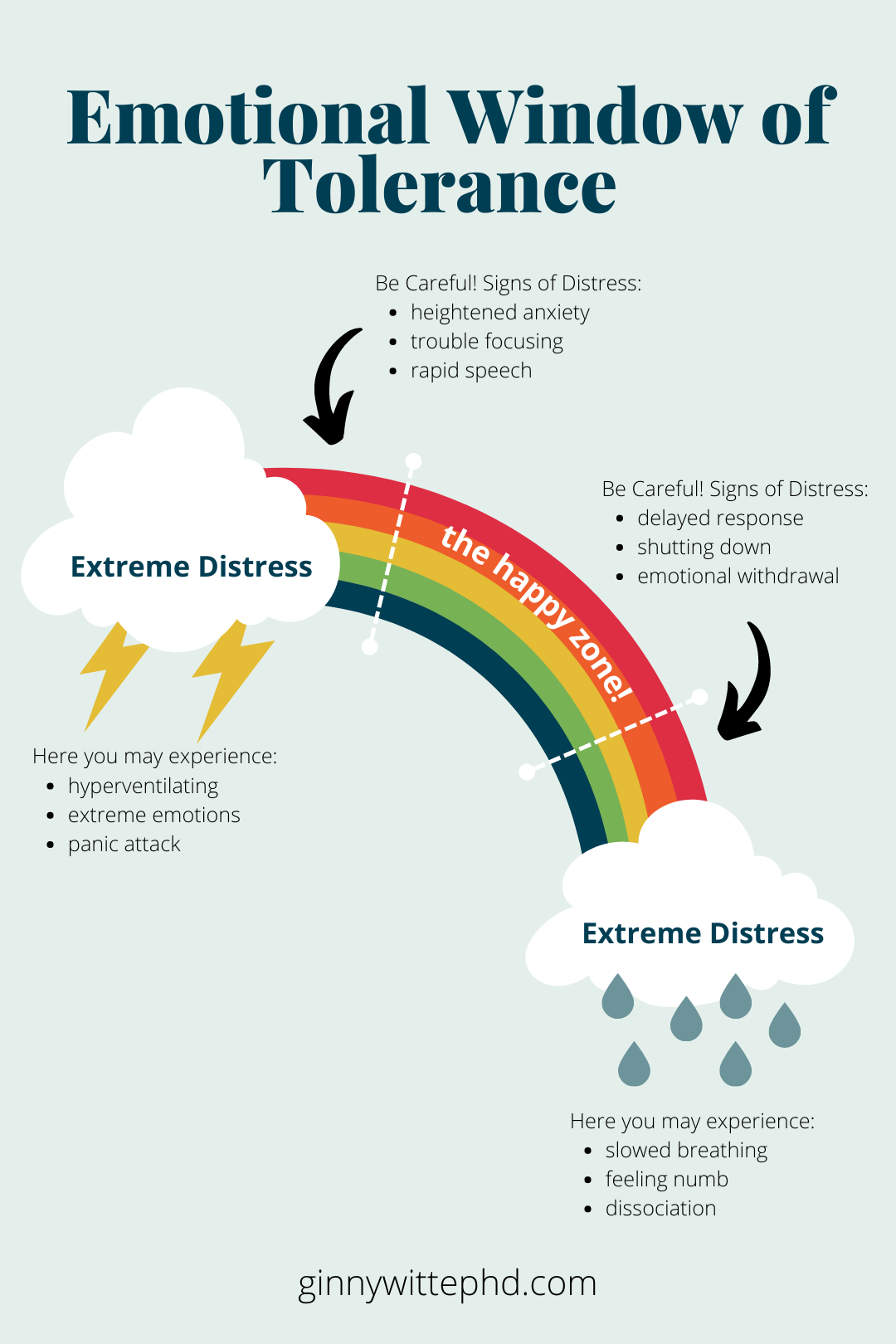The Polyvagal Theory has been particularly helpful to the clinical community in understanding trauma, especially developmental and complex traumas. Breaking down the states of the polyvagal theory has been especially helpful in aiding discussions between patients and providers.  Since 1994 when Porges introduced the theory, it has been widely used not only to understand trauma better, but in expanding research on trauma, and developing new treatment options. The theory is quickly being introduced and utilized in new professions and work.
Since 1994 when Porges introduced the theory, it has been widely used not only to understand trauma better, but in expanding research on trauma, and developing new treatment options. The theory is quickly being introduced and utilized in new professions and work.
When we look at behavior through the lens of the nervous system, we can better understand what it means to be fully human. We also see that how we sense, feel, and act are a result of our biology. The Polyvagal Theory also provides a language to help us articulate experiences of safety, threat, or trauma for understanding and growth. Clients and individuals now have a platform to understand and talk about their experiences, as well as exercises to implement for the nervous system to manage emotions and relationships. Utilizing the hybrid states of the polyvagal theory is an important part of this discussion and practice; but first, let’s start at the beginning with the primary states.
The Polyvagal Theory has been particularly helpful to the clinical community in understanding trauma, especially developmental and complex traumas. Breaking down the states of the polyvagal theory has been especially helpful in aiding discussions between patients and providers.  Since 1994 when Porges introduced the theory, it has been widely used not only to understand trauma better, but in expanding research on trauma, and developing new treatment options. The theory is quickly being introduced and utilized in new professions and work.
Since 1994 when Porges introduced the theory, it has been widely used not only to understand trauma better, but in expanding research on trauma, and developing new treatment options. The theory is quickly being introduced and utilized in new professions and work.
When we look at behavior through the lens of the nervous system, we can better understand what it means to be fully human. We also see that how we sense, feel, and act are a result of our biology. The Polyvagal Theory also provides a language to help us articulate experiences of safety, threat, or trauma for understanding and growth. Clients and individuals now have a platform to understand and talk about their experiences, as well as exercises to implement for the nervous system to manage emotions and relationships. Utilizing the hybrid states of the polyvagal theory is an important part of this discussion and practice; but first, let’s start at the beginning with the primary states.
First, let's understand the three
Primary States of the Polyvagal Theory
 According to the Polyvagal Theory, one of the main tasks of the nervous system is to ensure survival. The autonomic branch of the nervous system is a key player in this process, acting as a human surveillance system, and continually evaluating our internal and external world for threat. Within Once the nervous system makes its assessment, messages are sent through the body. milliseconds the body begins to adjust and meet the demands of the situation. Here, the body responds to cues of safety, and cues of threat. This is where behavior begins.
According to the Polyvagal Theory, one of the main tasks of the nervous system is to ensure survival. The autonomic branch of the nervous system is a key player in this process, acting as a human surveillance system, and continually evaluating our internal and external world for threat. Within Once the nervous system makes its assessment, messages are sent through the body. milliseconds the body begins to adjust and meet the demands of the situation. Here, the body responds to cues of safety, and cues of threat. This is where behavior begins.
Behavior begins with biology.
The Polyvagal Theory begins with three primary physiological states. Each of these states has their unique way of supporting survival, which will be covered briefly in this post. Find my full breakdown of the primary states here.
 According to the Polyvagal Theory, one of the main tasks of the nervous system is to ensure survival. The autonomic branch of the nervous system is a key player in this process, acting as a human surveillance system, and continually evaluating our internal and external world for threat. Within Once the nervous system makes its assessment, messages are sent through the body. milliseconds the body begins to adjust and meet the demands of the situation. Here, the body responds to cues of safety, and cues of threat. This is where behavior begins.
According to the Polyvagal Theory, one of the main tasks of the nervous system is to ensure survival. The autonomic branch of the nervous system is a key player in this process, acting as a human surveillance system, and continually evaluating our internal and external world for threat. Within Once the nervous system makes its assessment, messages are sent through the body. milliseconds the body begins to adjust and meet the demands of the situation. Here, the body responds to cues of safety, and cues of threat. This is where behavior begins.
Behavior begins with biology.
The Polyvagal Theory begins with three primary physiological states. Each of these states has their unique way of supporting survival, which will be covered briefly in this post. Find my full breakdown of the primary states here.
Ventral Vagal State
The newest branch of the parasympathetic system. A state of safety.
Here survival is supported through safety. In this physiological state you have access to your cognitive functions. This is where you connect with others, learn, grow spiritually, and can be your best self.
Sympathetic State
The sympathetic branch of the nervous system. A state of protection.
When things don’t go well in the ventral vagal state, or if you need more energy to mobilize, you move to the sympathetic state. A little of this energy and you feel alive and motivated. Too much and you can feel overwhelmed and the need to protect emerges. You will recognize this as your fight or flight state.
Dorsal Vagal State
The older branch of the parasympathetic nervous system. A state of shutdown and deep protection.
During times of threat and overwhelm the body has decided that it can go no further. Resources are too low and it’s time to shut down.
During times of safety the body does its repair and housekeeping. This is where you find deep rest and restoration. Your body restores the resources that have been used, consolidates learning, and flows into rest so that you are prepared for the next day.
Your nervous system is a beautifully orchestrated system that is designed to be flexible. At your best you continually adjust or make minor changes to attune your current experience. This is much like a musical conductor who motions to the orchestra when to create a rise in energy in the music to alert or excite you, or to slow the energy and intensity to bring you back down. Just as the orchestra communicates through the beautiful flow of musical sounds, your nervous system conducts the flow of energy through your body, communicating how you feel.
The hybrid states are an important piece of this orchestra.
Now, let's discuss the three
Hybrid States of the Polyvagal Theory
The States of Safety: Play & Intimacy
The Polyvagal Theory identifies six states: three primary states, and three hybrid states. The hybrid states are a combination of the primary states. They add complexity and depth to your life. They enrich and bring meaning to your presence and work. And, they also help you survive.
According to the Polyvagal Theory, both play and intimacy are hybrid states that ensure survival through safety and connection. Play and intimacy nurture the human soul. They connect us on a deep and meaningful level, helping us bond to raise young, and to survive by working together. The freeze response is a third hybrid state. The body may shift to this state when it is not feeling safe.
Ventral Vagal and Sympathetic Hybrid State
A perfect blend of safety and mobilized energy. A state of play.
In this state the body is able to utilize the vagal brake. While accessing the ventral vagal state of safety, it is also able to access some of the mobilizing energy of the sympathetic state. The beauty is that because the body feels safe, the vagal brake is able to hold down excess sympathetic energy and keep you within your window of tolerance. When you are within this window, you have full access to your higher level thinking skills, maintaining the ability to make cognitive choices with your emotions and behavior.
Play as a Neural Exercise
Most adults have enjoyed watching children having a great time playing together. At some point the children may tire, or become over excited. Soon that beautiful, playful energy spirals upward, sometimes out of control. As the mobilized energy is creeping up and children are not able to hold it in check, they move out of their window of tolerance. During times like this, when energy is too much, adults step in and guide the children.
 Play becomes a neural exercise. Children reach their capacity to manage their behavior, and adults bring them back down. We learn to coregulate with others, then practice and begin to do this on our own. Play is a fun and way to learn to regulate.
Play becomes a neural exercise. Children reach their capacity to manage their behavior, and adults bring them back down. We learn to coregulate with others, then practice and begin to do this on our own. Play is a fun and way to learn to regulate.
Activities may be things solo, like hobbies, writing, yoga, or meditation. It can also be activities with others such as dancing, singing, sports, collaborative projects, performances, games, or just having fun together.
Grownups and kids alike all love to play, connecting us to our deep internal self and others. Through play we experience those delicious feelings of pleasure, joy, curiosity, wonder, freedom, exploration, respect, acceptance, and connection. It is a powerful place where we like ourselves, and we like those we are with. We also like what we are doing.
Ventral Vagal and Dorsal Vagal Hybrid State
A blend of safety and immobilization. A state of intimacy.
Here is where we find intimacy. When the body feels the safety of the ventral vagal state and the stillness of the dorsal vagal state, closeness is created. Quiet, peaceful, and deeply connected.
You will recognize this state when you see a mother quietly embracing her infant to her chest. No words need to be spoken, the message is clear. Or when you observe a child and their pet snuggling close, two partners quietly embracing each other, or two friends quietly sitting together enjoying the moment. Spiritually you may feel connected to God or a higher being. There are numerous situations where you find this lovely connection without fear or mobilization. This place extends our range of feelings and emotions and beautiful feelings of peace, love, joy, connection, and safety are felt throughout the body.
This state is important in conceiving and raising our young. It is an important component of intimacy, conception, childbirth, nursing, and attachment, as well as aging well. It is through the availability and use of the social engagement system survival can now occur through connection rather than protection.
The Benefits of Play in Relationships
Both of these hybrid states allow for play; active and quiet. Play requires vulnerability as you are free to express yourself in different ways. These two hybrid states also allow for reciprocity. The act of reciprocity builds trust, which enhances connection and the reciprocity cycle continues. Through these experiences, the window of tolerance is expanded, allowing you to experience a broader range of emotions while remaining regulated. In essence, you are exercising the vagal brake. Thus play is beneficial to all of us for social, emotional, mental, and physical health and stimulation.
This also makes play a useful tool for working with trauma. Play can be an entry pathway when working with infants and children. It is also useful for therapists to use with clients since it builds trust and the capacity to manage more emotional shifts. Through the use of play, the therapist can create a path of trust to creativity, problem solving, seeing new possibilities, and creating a new story. Resolve and healing are available.
Individuals who have experienced abuse, neglect, complex trauma have nervous systems that have been tuned to sympathetic mobilization and dorsal shutdown. What was necessary as a young child has become an automatic response pattern that is no longer helpful as an adult. Through the use of play, the therapist can engage the client in behavioral practices that retune the nervous system to more helpful response patterns.
Sympathetic Mobilization and Dorsal Vagal Immobilization
The Freeze Response. A state of protection.
Your body doesn’t know what to do. You can’t fight, you can’t flee, you freeze. The freeze response can look like a deer in the headlights. You can’t run and you can’t stay. Neither can you think. You’re stuck.
Where the Dorsal state of shutdown is hypoarousal, the freeze response is hyperarousal.
The freeze response is often the result of early trauma and involves the opposition of attachment and fear, or the need to be close, and the need to run away. Your body doesn’t quite know what to do. The freeze state can feel like paralysis.
In the freeze state the sympathetic and parasympathetic branches of the nervous system are both active. The cortical brain goes offline. For clients or students this means it will be very difficult for them to engage, to have a conversation, or to make meaning of their feelings, sensations, or thoughts. They cannot fully process experiences. The limbic system is now in charge.
To help clients or students recover, they must first disarm the defense system. Since cognitive functions are not accessible, using a bottom up approach to help the individual recover often provides the most success.
When working with someone in the freeze state it is important to remember that their nervous system is overwhelmed. Our job is to reduce the stimulation, provide cues of safety, and respect their nervous system in the process. Watch carefully for changes, ask for permission, and use a calm, prosodic voice. Often eye-to-eye contact can be threatening and increase the overwhelm, so you may want to rely more on the voice than the eye contact. Too much emotion and too much expression coming their way increases the stimulation to an already overstimulated system.
With these three states we see that our biology is deeply involved in the expression of who we are and how we navigate our days. When we begin to recognize our physiological state and find our patterns, we can begin to exercise our nervous system to help it become more flexible.
With a more flexible nervous system we can meet the challenges of life head on and navigate the ups and downs with confidence and skill. Teaching others about their nervous system and guiding them through their physiological states by learning skills is a very rewarding endeavor.
And in the end, the possibility to feel and manage the full spectrum of feelings and life will bring great joy as we begin to access the fullness of who we are.
References:
Dana, C. (2018). The Polyvagal Theory in therapy: Engaging the rhythm of regulation. W. W. Norton & Co.
Porges, S. W. (2017). The pocket guide to the Polyvagal Theory: The transformative power of feeling safe. W. W. Norton & Co.
Porges, S. W. (2015). Play as a neural exercise: Insights from the polyvagal theory. Retrieved from https://www.legeforeningen.no/contentassets/6df47feea03643c5a878ee7b87a467d2/sissel-oritsland-vedlegg-til-presentasjon-porges-play-as-neural-exercise.pdf



